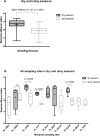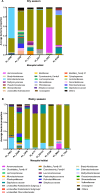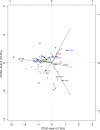Seasonality and Locality Affect the Diversity of Anopheles gambiae and Anopheles coluzzii Midgut Microbiota from Ghana
- PMID: 27322614
- PMCID: PMC4913965
- DOI: 10.1371/journal.pone.0157529
Seasonality and Locality Affect the Diversity of Anopheles gambiae and Anopheles coluzzii Midgut Microbiota from Ghana
Abstract
Symbiotic bacteria can have important implications in the development and competence of disease vectors. In Anopheles mosquitoes, the composition of the midgut microbiota is largely influenced by the larval breeding site, but the exact factors shaping this composition are currently unknown. Here, we examined whether the proximity to urban areas and seasons have an impact on the midgut microbial community of the two major malaria vectors in Africa, An. coluzzii and An. gambiae. Larvae and pupae were collected from selected habitats in two districts of Ghana during the dry and rainy season periods. The midgut microbiota of adults that emerged from these collections was determined by 454-pyrosequencing of the 16S ribosomal DNA. We show that in both mosquito species, Shewanellaceae constituted on average of 54% and 73% of the midgut microbiota from each site in the dry and rainy season, respectively. Enterobacteriaceae was found in comparatively low abundance below 1% in 22/30 samples in the dry season, and in 25/38 samples in the rainy season. Our data indicate that seasonality and locality significantly affect both the diversity of microbiota and the relative abundance of bacterial families with a positive impact of dry season and peri-urban settings.
Conflict of interest statement
Figures





References
-
- Wotton RS, Chaloner DT, Yardley CA, Merritt RW. Growth of Anopheles mosquito larvae on dietary microbiota in aquatic surface microlayers. Med Vet Entomol. 1997;11: 65–70. Available: http://www.ncbi.nlm.nih.gov/pubmed/9061679 - PubMed
MeSH terms
LinkOut - more resources
Full Text Sources
Other Literature Sources

